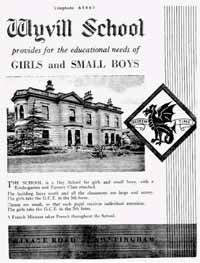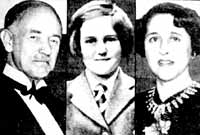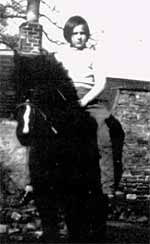Articles from the Thoroton Society Newsletter
Wyvill School and Murder
By Terry Fry

Last September I received a letter out of the blue from Professor Rene Weis, who teaches English at University College, London. He had discovered a piece by me online about Sherwood in Nottingham which included information about Wyvill School. It features in a book he is researching, although he did not offer the subject. I was curious and able to help by sending him all I knew about the school from my slim volume, The History of Sherwood, as follows:
‘Augustus Wyvill Hancock, a partner in Hancock and Son, blouse manufacturers, lived at Linden House, 4 Peel Street, Nottingham and it was at his family home that his daughters, HM and GE Hancock first established Wyvill School in 1925. They were joint headmistresses of this private, feepaying school until c.1936, when Hilda Hancock became the sole head. By this time the school had moved to its permanent home on Private Road, Sherwood. It remained a boarding school until the 1950s with about 100 to 120 pupils (girls and small boys) who wore distinctive red and grey uniforms.
Hilda took in Jewish children fleeing from Nazi Germany in the 1930s and in later years ignored the fact that some parents could not pay the fees. The school was closed in 1967 after Hilda Hancock died in January that year, and the building was demolished shortly afterwards.’
Professor Weis replied promptly and explained his interest in the school. One of its pupils was Elizabeth Drummond, the 10-year-old daughter of Sir Jack Drummond and his wife Anne, of Spence House, Nuthall. Sir Jack had been the first chair of Biochemistry at UCL, then the chief adviser on nutrition during the Second World War. Amongst his introductions were orange juice and cod liver oil. He also saved thousands of lives by devising a suitable liquid food, rather like porridge, for those liberated from the concentration camps. He was knighted in 1945 and appointed Director of Research at Boots in Nottingham in June 1946.

Sir Jack Drummond; Elizabeth; Lady Anne Drummond
In late July 1952 the Drummond family drove around south east France on holiday. They reached a spot near Lurs, a village in the remote Basses-Alpes, and camped by the road. Early next morning a local farmer found all three Drummonds murdered. Sir Jack and his wife had been shot and Elizabeth clubbed to death as she tried to escape over a bridge. The only items stolen had been their passports and other means of identification, but one of Elizabeth’s Wyvill School exercise books provided a means of identifying the family.
The motive for this terrible crime was never discovered. A local farmer, Gaston Dominici, was tried and sentenced to death but later pardoned by General de Gaulle. He was released in 1960 and died in 1965. No one knows for sure if he was guilty, but many other theories have been put forward. In particular, Professor Weis wants to put paid to dishonourable notions about Jack Drummond’s alleged life as a secret agent and industrial spy. What he intends to do, which French writers cannot do so readily, is to clarify the Drummonds’ lives by access to their files at UCL, the Wellcome Trust and The National Archives. Meanwhile, about every five years the French come up with another conspiracy theory. Orson Welles was one of the first to make a documentary, in 1953, about the murders.
 Elizabeth Drummond with her pony
Elizabeth Drummond with her ponyIn France, whenever the story crops up some people ask why it persists and the answer I always ‘la petite, quand-meme la petite’ (Elizabeth would have been 75 in 2017). Professor Weis became interested in the murders after coming across the Drummond graves in Forcalquier, a small town near Lurs. Apparently it is a most moving sight and scrupulously cared for to this day by the local Mairie.Currently, discussions are being held about erecting a monument to the Drummond family, near the entrance to the bridge across which Elizabeth fled that night.
< Previous